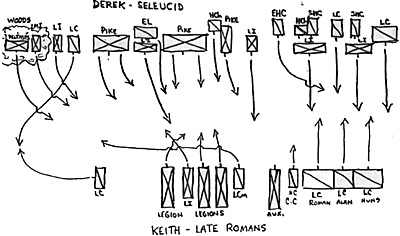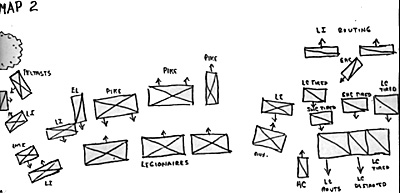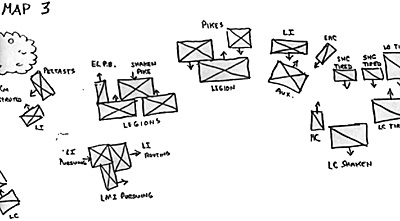Many writers took pen to paper last year about ancient wargaming, mainly regarding rules tournaments, and the health of the hobby. Many operate under misperceptions about some facets of it a diverse field. Just like I know little about Napoleonics or Colonial gaming periods, many know little about ancients. The following article will touch on why we play the way we do and give a description of our National Championship Tournament's final game.
We ancient gamers are an anamoly in miniature wargaming mainly because we run tournaments (just like like our boardgame brethren do) at conventions. We are an anamoly because we have adopted one set of rules to game the pcriool, WRG 7th. In theory, a player from California can play someone from Florida without eve having previously met. In practice, due to some vague aspects of the rules, players run into problems over 'interpretations', hence my reason for existing (Chief Umpire). I'm supposed to resolve disputes and rend, judgements in these situations. That in itself causes problems since many players are either aware or unaware of how I interpret the rules. Nevertheless, using a universal set of rules gets people together speaking more or less the same rules language.
We play for a variety of reasons, competition being the most popular and most hated reason. A tournament format that produces a clear winner (such as that in tennis or basketball) is a big drag. Unfortunately, that same "tournament mentality", in some cases, brings out the worse (and best) in some people. The stereotypical ancients gamer is some screaming fanatic measuring out his opponents move to the micro millimeter or screwing himself into the ceiling over an adverse ruling from the umpire.
I was sitting in the McDonalds across from the Penn Harris and overheard some of my non-ancient peers discussing ancients a using some words like "fanatics!. Fortunately, they had no comment on loud or unruly players. I think this bemuse most of us are pretty fanatical about the period. Yet our tournament games became much more so over the last several years for many reasons. An external emphasis on sportsmanship by other wargamer. magazines helped. A certain amount of peer pressure by us was also a factor. Really, most of us have just plain grown up, maturing a bit in the process. True, some bad apples still play, but at least they are quiet about it.
Still, aside from the competition, we play this game in an ahistorical way because we want to know how Ghcngis Khan would have fared against Hannibal. By placing certain parameters on the engagement, we test one military system against another. Many times, the player can really appreciate the genius of so generals.
So what is a National Championship?
We try to determine through a tournament format who is best 'Hannibal' for that year. Through a pretty informal system, groups from around the country play smaller tourneys that qualify persons to play in our Championship. In addition, this year we ran a scramble round the night before play started (borrowing a concept from golf tournaments) that put five more players in the pool-this year we had 36 players from 16 states and England. Armies ranged in time from Early Acheamenid Persian (about 450 B.C.) to Teutonic Knights (mid 13th Century). After three preliminary semi-final rounds, Derek Downs from Florida running Seleucids met Keith Smith from England with Romans. Derek won the tournament last year. This year we ran the final game in 15- mm on a 6x4 table.
There was little terrain. For those not familiar with the WRG system, players can "choose features and then dice for their placement. Keith picked four clear spaces (done to deny the opponent the chance to place terrain in a particular place) while Derek picked three woods and one river. He only got 2 woods on his extreme right flank. His terrain picks indicated Derek wanted to cut down the board size and concentrate his forces at one angle of attack. Keiths showed a desire to keep the board open for him to pick a spot and attack, not be forced into places he did not want to go.
Both armies are popular on the tournament circuit. Late Romans offer the player everything: outstanding infantry and a wide range of cavalry types. Roman Legionaries can be armed with pila, javelins, darts, and sub-machineguns (just kidding), making them a tough opponent. Seleucids also have a "combined arms" feel, having pikes, elephants, plenty of light infantry and cavalry, plus the potent scythed chariots.
 Map 1 shows each players initial deployment. Having the smaller army (because of more
expensive troop types), Keith deployed on just 1/2 the board. His Legionaries were in column to take advantage of their ability to turn quickly and deploy in line. Such a deployment significantly decreases the chance of being outdeployed, thus Keith left most of his options open. The significant number of light cavalry on Keith's right flank indicated he wanted to hold that flank long enough for his legions to close and break the center. Too few lights on the flank could be easily driven off.
Map 1 shows each players initial deployment. Having the smaller army (because of more
expensive troop types), Keith deployed on just 1/2 the board. His Legionaries were in column to take advantage of their ability to turn quickly and deploy in line. Such a deployment significantly decreases the chance of being outdeployed, thus Keith left most of his options open. The significant number of light cavalry on Keith's right flank indicated he wanted to hold that flank long enough for his legions to close and break the center. Too few lights on the flank could be easily driven off.
His single general was placed close to the lights for rallying purposes should any prematurely rout. Note the placement of the auxiliaries. These troops are just about as potent as the Legionaries themselves but move faster. By placing them between the lights and the legions, Keith again gave himself the flexibility of bringing them to bear when and where he needed them most. The long running historical argument about Alexander's use of the Hypaspists as the hinge between the phalanx and the cavalry might not be true, but its value was not lost on Keith. His auxiliaries were placed as the "hinge." The only weak aspect of his set-up was the lone light cavalry unit looking lost out on the left flank. Hence Keith's redployment of his light camels to that side during the first two turns of the game.
Derek on the other hand plays something he calls 'pin and punch" -- pin with the light troops, punch with the pike, elephants, or super heavy cavalry. Usually he has several punch units to either flank the pinned opponent or to hit someone again. When it works, the combination is devastating. Note how Derek interspersed his light troops either in front of or between his punch units. The only weak aspect of his deployment, given his tactics, was he should have had one additional light infantry unit with the pike/elephant block in the middle. The single fight infantry unit there turned out as not sufficient to pin all those legionaries.
The arrows on Map 1 show the initial move by both players.
 Map 2 shows the force dispositions at the end of turn 4. As stated, Keith moved his
camels to his left flank to help screen Derek's force of peltasts and LMI coming out or the woods. Most of the initial righting took place on Keith's right flank as the fast moving Hot cavalry forces fought for two turns. Neither could gain a decisive edge in the combat but the presence of Derek's SHC was the deciding factor. Derek succeeded in destroying one light cavalry unit and routing another, in the process, shaking Keiths general (who blew a morale test).
Map 2 shows the force dispositions at the end of turn 4. As stated, Keith moved his
camels to his left flank to help screen Derek's force of peltasts and LMI coming out or the woods. Most of the initial righting took place on Keith's right flank as the fast moving Hot cavalry forces fought for two turns. Neither could gain a decisive edge in the combat but the presence of Derek's SHC was the deciding factor. Derek succeeded in destroying one light cavalry unit and routing another, in the process, shaking Keiths general (who blew a morale test).
That left Keith with just one tired fight cavalry unit and the auxiliaries to protect the right flank while Keith's general tried to rally. However, Derek was unable to press home an attack for two reasons: most of his punch forces, mainly his SHC or scythed chariots, were either tired of expended and his extra heavy cavalry wasted two turns moving back and forth deciding who to attack. The indeciveness of the EHC effectively put them out of the game.
By turn four, Keith's strategy was apparent: move the legions up the middle hoping to catch the pike and elephants while holding both flanks. As this developed. Derek began to withdraw his pikemen, hoping to outdistance the legions and sucker them forward while he collapsed the flanks. It appeared that Derek never had any intention of getting his pike units into the battle but was hoping to pin the legions on both flanks and then punch with the pike. It's funny how we table top generals emulate historical tactics, the one Derek trying follows Cannae pretty well. It just goes to show you we can still learn loads by reading our history books. Keith's one attempt to stop the drive on the left flank was a roundabout march by his light camels. While it managed to pull off one light infantry unit and the peltasts, the points Keith lost were not worth the gamble.
Unfortunately for Derek, his plan almost backfired. Keith's legionaries finally caught up with the pikemen (Derek did not have enough time to prompt their continual retirement). That extra light infantry unit I mentioned would have slowed the Romans up. Derek's pikemen were finally forced to turn and right. Derek did succeed in turning Keith' left flank with one light infantry unit and his LMI Jews. The right flank held firm though. Keith's initial drive with his light cavalry, while costly in points, succeeded in tiring out most of Derek's punch troops, thus blunting the attack. Nevertheless, the troops Keith lost there eventually proved crucial. Keith's end ran with the light camels died in a hail of javelins and sling stones.
 Map 3 shows force dispositions at the end of the last turn (8). The Romans finally caught
the elephants and pike on turn 7 but lo and behold, were recoiled. The pike however, were disordered (which severely reduced their effectiveness). However, the pike/legionaire battle in the center was going decisively in Derek's favor when a combat die roll on turn 8 stalled the attack. However, Derek had another pike unit ready to charge on Turn 9. Given some normal random factor, the Romans would have routed.
Map 3 shows force dispositions at the end of the last turn (8). The Romans finally caught
the elephants and pike on turn 7 but lo and behold, were recoiled. The pike however, were disordered (which severely reduced their effectiveness). However, the pike/legionaire battle in the center was going decisively in Derek's favor when a combat die roll on turn 8 stalled the attack. However, Derek had another pike unit ready to charge on Turn 9. Given some normal random factor, the Romans would have routed.
The routing light infantry on Keith's left flank was just about exhausted at the end of turn 8, leaving the legionaires open to attack in the rear. However, Derek's pike block fighting the two legionairy infantry blocks blew a morale test and went shaken. I doubt it would have survived another turn. Timely charges in the rear could prevent the Seleucid right center from collapsing. We'll never know.
Nevertheless, Keith's left flank was hurting by this time with no reserves to push in and close the gap. Over on the right flank, Derek finally had the EHC in a position to charge the auxiliary and had enough troops to screen the now-rallied general from interfering. The size of the auxiliary unit (36 figures) would make such a charge a gamble. Derek would have to depend on the auxiliaries blowing a morale test as a result of the charge. Like on the other flank, we'll never know.
The four hour time limit stopped the game after eight turns. If fought in "real life", the battle lasted two hours. Derek won on points 263-218. Those light cavalry forays on both flanks cost Keith the game. However, if he had done nothing, it could have been over sooner. As it was, the battle on the left flank was in doubt, depending on whether Derek's pike unit broke. While the elephants were ready for another charge, the pike's ability to hold was important.
Still, Keith's other legionary unit would need good luck to survive the charge by the pike block. Yet if both players trade infantry blocks on turn 9, the point cost was still in Derek's favor (202 for the Legion to 155 for the pike). Nevertheless, it was close. Derek's real advantage at the end of the game was his reserve troops. Keith had none. Another real life military axiom again coming true on the table top.
Both players only partially executed their respective battle plans in time. Derek's lack of fight infantry in the middle forced him to unwillingly turn and right. Keith's ineffective screen on the left flank left him vulnerable. Yet his staunch defense of the right flank prevented a real dimmer. However, it was an expensive holding action, he lost almost 200 points to Derek's 120. Not a bad trade (for Derek) when playing a tournament game to a time limit. Each player fought a close game and were evenly matched. Both scored big victories in the earlier rounds, final being one of the closed ever. Both Keith and Derek will be back ncx year to again play in the National Championship Tournament.
Hopefully you non-ancient gamers now have a feel for our tournaments and how one game plays. I also hope you ancient gamers out there fed up with the alleged unhistorical aspects of WRG 7th edition can take heart in tactics. This replay shows both players know their history, that historical tactics do work on the table top with the rules, and that you can have success by emulating our predecessor's battle plans.
Back to Saga v3n6 Table of Contents
Back to Saga List of Issues
Back to MagWeb Master Magazine List
© Copyright 1989 by Terry Gore
This article appears in MagWeb (Magazine Web) on the Internet World Wide Web. Other military history articles and gaming articles are available at http://www.magweb.com